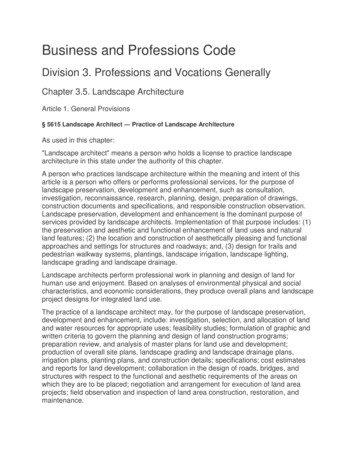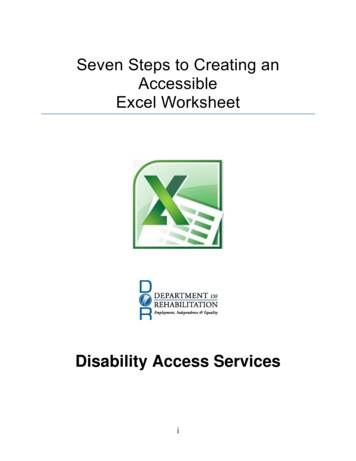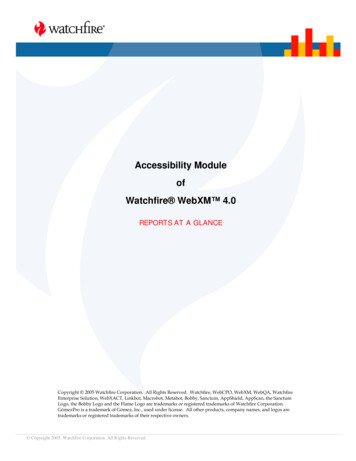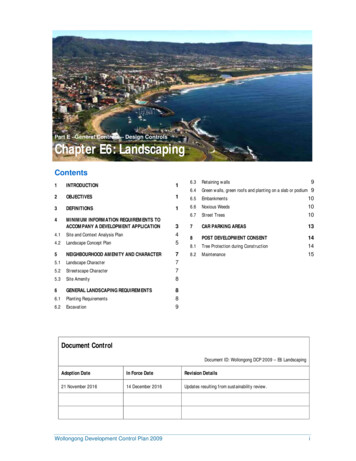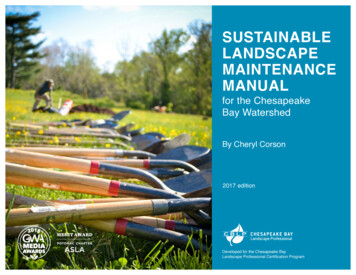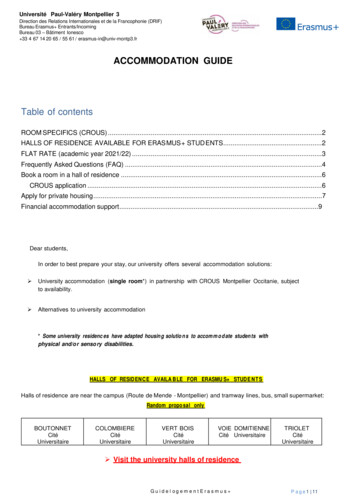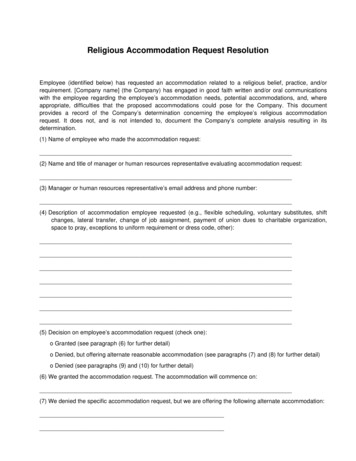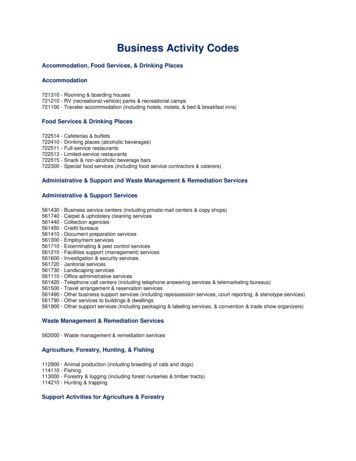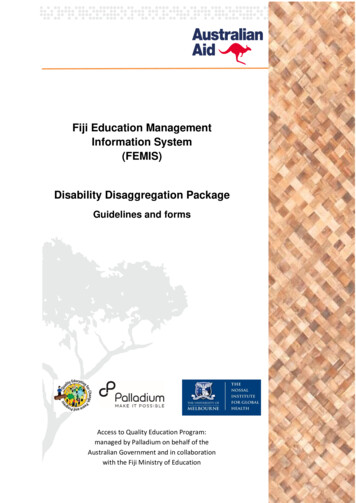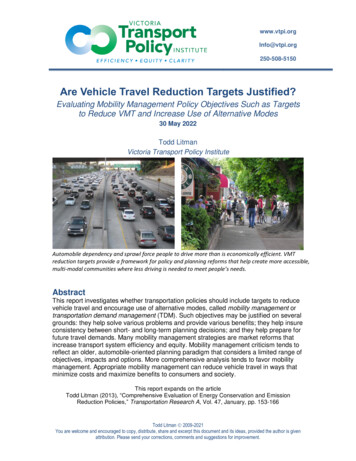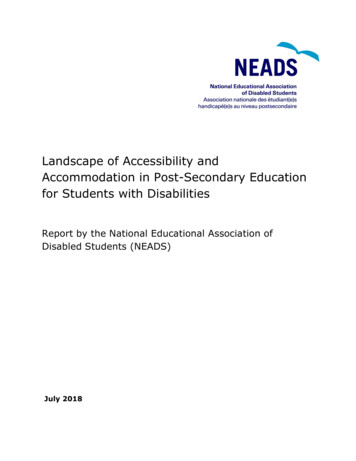
Transcription
Landscape of Accessibility andAccommodation in Post-Secondary Educationfor Students with DisabilitiesReport by the National Educational Association ofDisabled Students (NEADS)July 2018
Table of ContentsExecutive Summary . 1Key Messages . 4Section A. Here’s What We’ve Done . 13Section B. Reflections on the Landscape of Post-SecondaryEducation in Canada . 16Section C: Disability Legitimization and the Post-SecondaryEducation Environment . 43Section D: The Educational Journey of Students withDisabilities in Post-Secondary Education . 58Section E: Recommendations . 117Section F: Bibliography . 131Appendices . 148
1Executive SummaryThe ‘Landscape of Accessibility and Accommodation’ project represents athorough examination of the current landscape of accessibility, services,accommodations, technical equipment and supports for students withdisabilities at publicly-funded post-secondary institutions across Canada.This research on post-secondary access and services is timely. It contributesto the Government of Canada's emphasis on access to education andtraining for persons with disabilities, leading to their participation in thecompetitive labour market. More specifically, the purpose of this project andsummary report has been to inform the Government of Canada’sconsultation on the development of a new federal disability act.The project was funded primarily through a contribution agreement andsignificant funding from the Social Development Partnerships Program ofEmployment and Social Development Canada. We thank the Government ofCanada for supporting this important initiative. We would also like toacknowledge with thanks grant funding from the Canadian Education andResearch Institute for Counselling (Counselling Foundation of Canada) andthe Ontario Human Capital Research and Innovation Fund (Ontario Ministryof Colleges and Universities).The project included a team of researchers working across Canada inOttawa, Toronto, at Simon Fraser University in British Columbia, AssiniboineCommunity College in Manitoba, and Memorial University of Newfoundlandand Labrador.It’s important to note that we employed about 15 graduate students withdisabilities to conduct most of the research in locations across Canada.Through our consultations with students with disabilities, faculty, staff andpolicy makers across the country within the Canadian post-secondarysystem, we have consistently heard several key messages: In many ways, accessibility remains silo’ed within post-secondaryeducation; progress toward models of inclusion and universal design isslow and exists in pockets across the country; Good faith efforts to improve accessibility and inclusion for studentswith disabilities exist within the post-secondary system;
2 Accessibility and inclusion efforts in the post-secondary environmenthave lagged behind the evolution of the student experience, and arelimited to the academic (classroom and online learning) environment;in particular, accessibility in the co-curricular, professionaldevelopment and work-integrated learning spaces needs to bedeveloped; The intersectionality among universal design for learning,differentiated instruction, and essential requirements for courses,programs and disciplines in the context of accessibility and individualstudents’ learner pathways has not been effectively understood withinthe post-secondary context; Significant transition barriers into, between, and out of levels of postsecondary education remain, with particular challenges faced bystudents transitioning into post-secondary, and from post-secondaryinto the labour market; Accessibility and inclusion in the post-secondary environment arelagging behind technological advances; we continue to focus onspecialized assistive solutions, as opposed to mainstream technologicalsolutions, to accessibility challenges; and, Strong regional and provincial disparities exist within respect toinstitutional and provincial policies and practices around accessibilityand inclusion in post-secondary education.Continued progress toward a universally designed and inclusive postsecondary education environment for all students requires a renewed andnationwide commitment toward this goal. Ultimately, work in this spaceneeds to adhere to two primary guiding principles:1. Recognition of the student’s individual lived experiences and learnerjourney, and the impact they have on the student’s accessibility needsin education and employment, particularly as related to theinteractions among social assistance, financial aid and livedcircumstances with the educational environment.2. Accessibility and inclusion legislation, policies, practices and guidelinesmust recognize the evolving nature of disability and accessibility forindividuals over time (particularly for individuals with chronic, episodicand degenerative disabilities), and in consideration of the evolvingnature of the interaction among disability, technology, and thelearning and workplace environments
3In this report, we provide a series of legislative recommendations, as well asrecommendations for key stakeholders (federal and provincial governments,institutions, service providers, and professional societies, among others)which are intended to further progress toward accessibility and inclusion inCanadian college and university education.
4Key MessagesSocial Determinants of Health and the PostsecondaryLearning EnvironmentKey Message: Disability is part of the range of human experience, andhuman variation, and this perspective should inform our perspectives onpost-secondary education and the learning environmentKey Message: Post-secondary education is a social determinant of health –a means to employment, economic stability, and overall health and longevityEvaluating the Postsecondary Landscape for Studentswith Disabilities, 1990s-2010sKey Message: Advances in technology, infrastructure and legislation,coupled with changes to the demographics of students with disabilities inuniversity and college education, means that our policy frameworks need toevolve to remain current with the changing needs of learners.Grounding Accessibility in Post-Secondary Education inthe Student’s Life ContextKey Message: Students with disabilities experience an additional ‘cognitiveload’ associated with navigating their lived experience with a disability, bothwithin and external to the educational environment. Accessibility within thepost-secondary environment must therefore take into consideration thestudent’s lived experiences external to their education, which may impacttheir education.Equity, Diversity and Inclusion in Canadian PostSecondary EducationKey Message: Measures of representation and diversity (i.e., headcounts ofpersons with disabilities in post-secondary institutions and programs) arenot reflective, nor representative, of measures of inclusion.Key Message: Diversity and disability ought to be considered as learningstyle elements, not as demographic labels.
5Characteristics of the Students with DisabilitiesPopulation in CanadaKey Message: The population of students with disabilities in Canada isdiverse and multi-faceted, and it is not practical to develop a profile of the“typical” student with a disability.Key Message: Individual circumstances (including other elements of socialidentity, employment and housing situation) are likely to impact thestudent’s learner pathway and need to be taken into consideration inevaluating accessibility and the student experience.Students with Disabilities in Graduate Education: The2016 Canadian Graduate and Professional StudentSurvey DataKey Message: Graduate students with disabilities experience theireducational journeys in subtly and overtly distinct ways from their nondisabled peers.Key Message: Overall, graduate students with disabilities experience lowerlevels of satisfaction, both academically and socially, and identify as havinggreater difficulty navigating the academic, professional development andcampus social environments at their institutions.Undergraduate, Professional and College StudentDatasetsKey Message: Significant disparities exist between the university andcollege sectors with respect to the nature and type of student engagementdatasets in Canada.Key Message: A nationwide college student engagement survey, utilized bya majority of publicly-funded college campuses, does not exist, and presentsa significant barrier to a comparative understanding of the collegeexperience of students with disabilities. Province-by-province disparities inthe collection of college student engagement data also exist.
6Environmental Scan of Institutional PoliciesKey Message: Institutional policies around accessibility and accommodationare variably and inconsistently implemented nationwide. Geography,institution type and governance structure are reflected in the currency andextent of institutional buy-in for accommodation policies.Attitudinal Barriers and the Accommodation ModelKey Message: Attitudinal barriers, such as the ‘gatekeeper function’ ofthose who determine whether or not an accommodation will be made (e.g.,staff at Disability Services Office; faculty/instructors who receiveaccommodation requests), are based on implicit biases and a lack of trainingand experience, and often negatively impact the experience of students withdisabilities.Key Message: The current accommodation model, based primarily on adisclosure of needs framework, forces students to ‘legitimize’ theiraccessibility requirements, and adds stresses and cognitive load to theeducational journeys of the students.Key Message: Self-advocacy, intended to be a tool that benefits thestudent, can perpetuate the very issues of discrimination, labelling andlegitimization that it is designed to resolve.Key Message: The accommodation model and self-advocacy frameworkneed to be re-imagined according to the principles of inclusion and universaldesign.Documentation and Triage of Students with DisabilitiesKey Message: Differing operational definitions of disability and/or levels offunctional impact between institutions may negatively impact students’likelihood of receiving needed accessibility solutions for their educationaljourneys.
7Figure by Michaela Burton, Primary Author & Researcher
8Legitimization & Cognitive OverloadKey Message: Cognitive overload as a result of the need for legitimizingone’s accessibility requirements in post-secondary education can negativelyimpact a student’s educational journey and mental health.Consequences of the Accommodation Model inPostsecondary EducationKey Message: Students with disabilities may experience significant barriersin their university or college education and in becoming full participants insociety, resulting from implicit biases in the perception of their socialidentities.Key Message: Student success in navigating the accommodation model inpost-secondary education does not translate to recent graduate success inthe workforce.The Evolution of the Student Experience, 1990s-2010sKey Message: The student experience in post-secondary education hasevolved over the past 20 years to include not just the academic learningenvironment, but also the co- and extra-curricular spaces within universityand college, as well as work-integrated learning, academic employment andthe campus social environment. Accessibility for students with disabilitiesattending colleges and universities needs to integrate all aspects of thestudent experience, not just the classroom learning context.Admissions and Student TransitionKey Message: Significant structural, navigational and environmentaldifferences exist between the K-12 and post-secondary learningenvironments. A strong need exists for students with disabilities tounderstand the cultural differences between these stages of education, andto learn effective management strategies.Key Message: Equal access to technology – both mainstream andassistive – is essential in fostering student success in their educationaljourneys. Legislative and governmental programs to ensure technologyliteracy and access are beneficial to students from diverse backgrounds, inorder to achieve equal access and equal opportunity for success.
9Key Message: Mainstream devices are beginning to supplant specializedassistive technologies in some applications, and their eligibility aseducational aids in funding for studies and assistive device provisionprograms ought to be considered.Key Message: A single set of standards for disability documentation,focused on functional impact of disability and accessibility requirements,ought to be established, and should be ‘portable’ for students nationwide.Essential Requirements, Differentiated Instruction, andAccessibilityKey Message: Designing effective accessibility solutions for students withdisabilities requires knowledge of the essential requirements of the course,program or discipline, as well as the functional impact of the student’sdisability(ies) in the context of the learning environment(s) the student is in.Key Message: Disability can be conceived of as different learning styles –differences in how we envision the world around us, and differences in howwe take in, process and communicate information.Key Message: Recognizing that every student is a unique learner, withunique learning needs, enables a perspective shift among educators andpolicy makers to embed accessibility as a way of thought within the postsecondary education system.Key Message: Accessibility solutions may be beneficial to other students’diverse learning needs, not only to students with disabilities.Breaking the Silo’ed Approach to AccessibilityAccommodations: Toward Universal Design in the PostSecondary Learning EnvironmentKey Message: A universally designed post-secondary educationenvironment recognizes that space, learning and the human environmentmust all be accessible and inclusive.Key Message: A universally designed human environment within postsecondary education takes into account the principles of flexibility,dynamism, collaboration, positive relationships, essential requirements, andthe many aspects of student life.
10Accessibility of STEM Careers in Canada’s KnowledgeEconomy for Youth with DisabilitiesKey Message: Training and employment in science, technology, engineeringand mathematics (STEM) disciplines are increasingly important in Canada’sgrowing knowledge economy.Key Message: Youth with disabilities are under-represented in STEMdisciplines and STEM careers.Key Message: Youth with disabilities face many barriers to participation inSTEM careers, including educator and employer preparedness, awarenessand attitudinal barriers.Key Message: Work-integrated learning (or pre-employment learning)experiences are important for both employers and youth with disabilities inSTEM fields, in order to provide needed exposure for both the youth and theemployer.Key Message: Appropriate mentorship and the existence of role models intheir careers are crucial to the professional development of youth withdisabilities in STEM fields.Key Message: Employer peer mentorship through professional networks isimportant to ameliorating employer attitudes around youth with disabilitiesin STEM.Key Message: Programs fostering the adoption of universal design practiceswithin the workplace will ameliorate barriers faced by youth with disabilitiesin STEM careers, as it does in the post-secondary academic learningenvironment.The Co-Curricular Learning Environment in PostSecondary EducationKey Message: The co-curricular learning environment is an increasinglyimportant space within the college and university settings but is one that hasbeen developed without concurrent thought to accessibility support.Key Message: Navigating the co-curricular learning environment in theabsence of established accessibility supports presents a significant barrier to,and increases the cognitive load of, students with disabilities.
11Key Message: Students with disabilities, in managing their livedexperience, accumulate experiences that mirror those obtained throughformal co-curricular learning.Professional DevelopmentKey Message: Persons with disabilities remain underrepresented in thelabour force. Post-secondary student experience, in particular professionaldevelopment programming, have become increasingly essential to theemployability of students. However, these programs are not often accessibleto students with disabilities, and represent a significant barrier to theiremployability.Career Transition and Career EducationKey Message: Many barriers to employment for students and recentgraduates with disabilities link to career transition supports and the cocurricular program environment within the post-secondary system.Key Message: Post-secondary institutions’ career exploration offices, aswell as government programs and legislative priorities, play an importantrole in influencing employer attitudes around disabilityKey Message: Sustained programming – e.g., mentorship, networking, andone on one engagement – enhances the likelihood of employment forstudents with disabilities, and enhances employer attitudes towardemployees with disabilities through prolonged exposureKey Message: Transition support programming is beneficial in preparingstudents for the workforce, and for ensuring they are appropriately ready forthe different accommodation frameworks in place in the workplace comparedto the educational environmentFirst Nations, Métis, and Inuit Students With DisabilitiesKey Message: A significant gap exists in our understanding of theexperiences of students who self-identify as Aboriginal, a term used inclusiveof Canada’s First Nations, Métis, and Inuit peoples, and as living with adisability – within the research literature and within practice.
12Accessing Student ServicesKey Message: Students have often looked at their engagement withstudent services portfolios as a “one stop shop” and have worked throughtheir disability/accessibility services offices. Meanwhile, student servicesstaff are often lacking appropriate training in working with students withdisabilities.Key Message: Student Experience is comprised of social integration &academic integration. To change culture around accessibility, there needs tobe supplementary advocacy.Key Message: Implicit Bias is an inefficiency to the Accommodation Model.Key Message: Institutions require support that will provide UniversallyDesigned learning environments that are founded upon empirically groundedresearch.
13Section A. Here’s What We’ve DoneThe ‘Landscape of Accessibility and Accommodation’ project represents athorough examination of the current landscape of accessibility, services,accommodations, technical equipment and supports for students withdisabilities at publicly-funded post-secondary institutions across Canada.This research on post-secondary access and services is timely. It contributesto the Government of Canada's emphasis on access to education andtraining for persons with disabilities, leading to their participation in thecompetitive labour market. More specifically, the purpose of this project andsummary report is to inform the Government of Canada’s consultation onthe development of a new federal disability act.The ‘Landscape’ research to-date has achieved the following ProjectObjectives:1. Assessment of the landscape of academic accommodations forstudents with disabilities in the Canadian post-secondary educationsector, as it has evolved over the past 20 years of legislative,attitudinal, technological and demographic change;2. Assessment of the landscape of co-curricular and experiential learningaccommodations for students with disabilities in the Canadian postsecondary education sector, in order to establish a benchmark for bestpractices and future directions in this area;3. Assessment of the landscape of accessibility and accommodationpractices for students with disabilities in transitional spaces: postsecondary admissions, transition to employment programming, andstudent mobility between institutions;4. Assessment of the evolution toward the principles of accessibility anduniversal design in working with students with disabilities in Canadianpost-secondary education;5. Providing commentary on accessibility and accommodation within theacademic and co-curricular learning environments in the context of:Trades; college certificate/diploma programs; universityundergraduate programs; first- and second-entry progression degreeprograms; and, professional and research-stream graduateprogramming;
146. Understanding trends in accessibility and accommodation withinCanadian publicly-funded colleges, primarily undergraduateuniversities, comprehensive universities and medical/doctoraluniversities;7. Establishing a national collaborative network of consumers, academicsand practitioners in the intersection between higher education policyand student experience for students with disabilities in Canada.To achieve these goals, we undertook a series of research initiatives,outlined below:1. An environmental scan and analysis of public-facing accessibilitypolicies at publicly-funded Canadian colleges and universities.2. A literature review of existing research into services, accommodationsand supports for persons with disabilities in Canada's post-secondarysystem. This review was Canadian focused, but also includedinternational literature and studies.3. Analysis of large national or provincial student engagement datasetsthat included the disability demographic question, in order tounderstand comparative measures of the student experience forstudents with disabilities relative to the overall population of students.These datasets included:A. The Canadian Graduate and Professional Student Survey (CGPSS)2016 instrument, administered to graduate students atparticipating universities nationwide;B. The Canadian University Survey Consortium (CUSC) instrument,administered to 1st year, mid-year and graduating undergraduatestudents (2014-2016) at participating universities nationwide;and,C. The Ontario College Student Satisfaction Survey (OCSSS) 2016instrument, administered to college students in Ontario.4. Analysis of the CGPSS dataset is complete; analyses of the CUSC andOCSSS datasets are in progress and will be completed in early Fall2018.
155. A cross-disability, bilingual online survey of college and universitystudents with disabilities covering topics associated with accessibilityand accommodation, which may include, but not be limited to: physicalaccess, academic accommodations, accommodations in the cocurricular setting, adaptive/technical equipment, provision of academicmaterials in formats of choice, mental health services, mentoring,cooperative education/internships opportunities, and social inclusion.The survey instrument has been designed and is going through ethicsapprovals for deployment in fall 2018. Analysis of this dataset will becompleted in early 2019.6. Consultations with accessibility/disability services staff, student lifeprofessionals and other relevant academic leaders at nationalconferences of those stakeholder groups. Stakeholder groups andconferences were attended over the course of one calendar year(March 2017-February 2018), and included representatives from thefollowing sectors:-Senior academic administrators (college and university)-Graduate deans-Faculty and higher education researchers-Teaching and learning staff and faculty-Student services directors-Student life and professional development professionals-Career educators-Co-op placement officers-Student financial aid administrators-Disability services staff-Accessibility experts-Counsellors and campus mental health staff-Librarians-Providers of academic materials in accessible formats
16Section B. Reflections on the Landscape ofPost-Secondary Education in CanadaSocial Determinants of Health and the Post-SecondaryLearning EnvironmentKey Message: Disability is part of the range of human experience, andhuman variation, and this perspective should inform our perspectives onpost-secondary education and the learning environmentKey Message: Post-secondary education is a social determinant of health –a means to employment, economic stability, and overall health and longevitySocial determinants of health (SDH) are increasingly recognized as leadingculminative, and compounding factors that are part of the human experiencein shaping health, and health outcomes throughout the lifespan (McGibbon &Etowa, 2007; McGibbon, 2009; McPherson & McGibbon, 2010). In today’sCanadian landscape, the Canadian Council on Social Determinants of Healthhas advised on 7 leading frameworks that unpack simultaneous variablesthat determine health other than biological endowments and geneticpredispositions, to include: income, living environment, education, workingenvironment, childhood experiences, and quality of life (PHAC, 2008;CCSDH, 2015; Raphael, 2009Raphael, Bryant, & Rioux, 2006).Higher Education is becoming increasingly recognized by authors as a socialdeterminant of health within a globalized knowledge economy (Harrison,2015; Jung, 2002; Mitrou, 2014; Shankar, 2013). Gaining access to skillssuch as ‘computer literacy’ has become a basic prerequisite to earning stableemployment and meeting basic needs for standard quality of life in a NorthAmerican Context (England, 2003; Fichten, 2003).However, based on a scan of the current Canadian landscape, there is asuggestion that students who identify with a disability are at an increasingdisadvantage from a health inequities perspective, and social determinantsof health perspective, when applying an intersectional framework (Bauer2013; Benoit, 2013; Fichten, 2003; Jung, 2002; Mitrou, 2014; Reed &Curtis, 2012; Raphael, Bryant, & Rioux, 2006; Ostrowski, 2016; O.Hankivsky and A. Christoffersen, 2008; Shankar, 2013).
17For example, individuals who identify with a disability and who complete apost-secondary education earn significantly less and have a harder timesecuring a stable form of employment (NCD2007; Roeher Institute 2004;Shier, Graham, and Jones 2009; Zarifa, 2015). Robson et al.’s (2014) studyon special needs high school students from the Toronto District School Boardfound that disability impacted post-secondary education enrollment rates,noting that students with disabilities were far more represented at thecollege level, while being less likely to pursue a university degree.A person’s perceived social identity has become critically important forunderstanding practical health outcomes such as quality of life, or socialdownward mobility that is associated with chronic illnesses (Benoit et al.2005, 2010; Jansson et al. 2010; Jung, YEAR The Earnings and EmploymentOutcomes of the 2005 Cohort of Canadian Postsecondary Graduates withDisabilities; Olena Hankivsky 2012; Shankar 2013;).Intersectionality and the Learning ProcessA Federal Accessibility Legislation that first recognizes human variability,within a greater context of social variability, will be the beginning of thejourney towards a more accessible and inclusive Canada. Hankivsky (2008)writes about the urgency of incorporating an intersectional framework fordeveloping policy, conducting research, and rationalizing more practically,when it comes to handling issues around citizens’ health determinants, andclosing severe inequities in health care, and education for groups whocontinue to be excluded (Hankivsky & Christoffersen, 2008). The strength inintersectionality as a foundation to understanding learner experience, andidentity, is the ‘multiple interconnecting impacts of policies and practices ondifferent groups [acknowledging] the historically situated and alwaysemergent power of structures (Lee, 2005).An Intersectional framework is marked as an integrative and dynamicapproach which addresses fluid and shifting processes of time and locationfor social agents; analyses ‘moves beyond single or typically favouredcategories of analysis’ such as sex, gender, race, socioeconomic status,creed, religion, and considers the simultaneous interactions between socialidentity as well as the impact of systems and processes of oppression anddomination (Hankivsky & Cormier, 2009).Regarding intersectional health research, Bauer points out that discussionsaround intersectional identity and social determinants are not only relevant,
18but important in the context of social labelling which occurs within CanadianPost-Secondary Education institutions.An increasing emphasis has been placed upon the notion of perceived socialposition, such as the medical model of disability which exists in theaccommodation model. This differs largely from perceived social identity; theformer referring to the ‘social objective measurement’ by which one isperceived and treated by others (Bauer, 2014; Holt 2008).Though one may identify as a complex of variable traits, which can shift inaccordance to time and place, the perceived social position is what isunderstood by others and that can affect the individual’s health (Bauer,2014; Hankivsky, 2008).Evaluating the Post-Secondary Landscape for Studentswith Disabilities, 1990s – 2010sKey Message: Advances in technology, infrastructure and legislation,coupled with changes to the demographics of students with disabilities incollege and university education, means that our policy frameworks need toevolve to remain current with the changing ne
Key Message: Disability is part of the range of human experience, and human variation, and this perspective should inform our perspectives on post-secondary education and the learning environment Key Message: Post-secondary education is a social determinant of health - a means to employment, economic stability, and overall health and longevity

